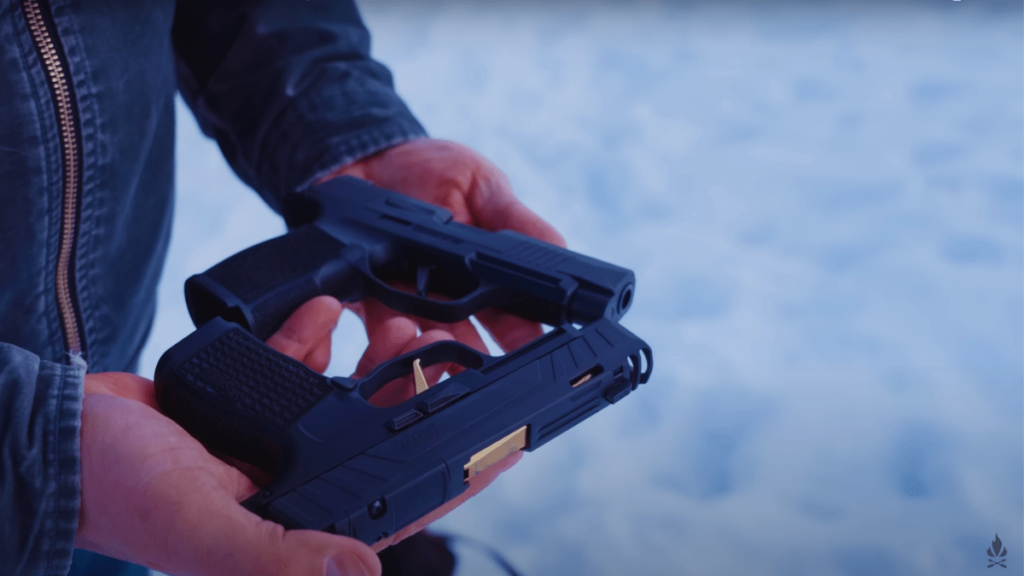Featured image credit: Youtube.com/@controlthegun
The SIG Sauer p365 is often cited as one of the best concealed-carry pistols on the market, largely due to its compact and lightweight design and ease of concealability.
However, that reputation has been tempered by a series of less-than-stellar reports about the multitude of SIG p365 problems that can crop up with the popular handgun.
So many problems, unfortunately, that’s it’s possible to compile a list of them. Let’s take a look at the most common SIG p365 problems users are facing.
Night Sight Issues
Upon its release, the SIG p365 immediately took a lot of heat over its night sights. A number of the sights were either not visible at night (which is, inevitably, a slight problem with a night sight) or were breaking off altogether.
The problem was so ubiquitous SIG Sauer actually temporarily stopped selling the p365 so that they could address the issue.
It was, thankfully, quickly resolved. They immediately upgraded the night sights on all p365s they held and sent out replacement night sights to anyone who’d already bought the handgun.
Thus, a PR disaster was neatly sidestepped.
Poor Striker Design
A much more serious problem than the night sight one was the egregious design of the pistol’s striker.
After a short time, many people were reporting that the firing pin in their p365 was damaged or completely broken.
A big part of this was down to the guns being “dry-fired” (e.g. the trigger being pulled when the chamber was empty), which put the firing pin under undue stress.
This is a problem that many other smaller concealed-carry handguns had too, but the issue seemed to be worse in p365s.
Later generations of the pistol seem to have corrected this design oversight, but it nevertheless remains a sore point from the early days of the p365.
Failure to Extract

Another very serious problem – but one that doesn’t appear to have been completely eliminated with more recent iterations of the p365 – is the so-called ‘failure to extract’ issue.
This is when the spent casing of a discharged round is not ejected from the chamber. It can, it goes without saying, be utterly calamitous if this happens in a situation where you need to fire multiple rounds in rapid succession.
Failure to extract can be caused by a malfunctioning extraction claw, a dirty chamber, failures in case rims, or any other number of reasons.
Whatever the precise reason in the SIG p365 is not clear, but given the number of times it’s happened to various users (and, more worryingly, the frequency with which it’s happened), it’s still a bloodied nose for SIG Sauer’s reputation.
Extended Clip Problems
One of the p365’s best features is that it combines a high-capacity 10-round magazine with a compact design, making it one of the few easily concealed handguns with such a deep clip.
Not content with a 10-round clip, however, SIG Sauer took it further and released an extended 12-round magazine.
This seemed like a great idea; who wouldn’t want an extra 20% capacity on an already-generous clip size?
In practice, however, it turned out that the extended clip was extremely difficult to load, if not impossible.
The issue apparently boiled down to an overly stiff magazine spring that meant that only the brawniest of users were able to slot it in.
Great if you’re Arnie; not so good for everybody else.
Failure to Go into Battery
Not as common as some of the other problems on this list, the p365’s reported failure to go into battery is nevertheless a serious enough issue to warrant a mention.
First, a brief explanation: a gun is considered to be “in battery” when the bolt or slide is in the correct position and ready to fire. It is “out of battery” if the slide/bolt is not in position.
This typically only happens for a moment after the gun has been fired and is readily observable in handguns of this sort when the slide jumps back.
Not returning to battery is a pretty big problem and can sometimes result in out-of-battery discharges – a potentially life-threatening situation.
Thankfully, out-of-battery charges are vanishingly rare in modern guns like the p365 (which are designed not to ever discharge out of battery), but it’s still a pretty big problem that SIG Sauer absolutely needs to address.
Trigger Return Spring Problems
This one is perhaps the least serious complaint levied at the popular concealable firearm, but a problem is a problem.
This one can generally be detected when pistol clips are found to have scratches on the backside after being ejected.
The cause is an improperly-sized trigger return spring (TRS) that is overly long and thus scratches the back of the magazine when it’s ejected or loaded.
The user may also observe a rattling sound when loading or ejecting a clip.
This one is, as noted, not quite as big of an issue as some of the others (a scratched magazine is never going to be as problematic as failures to extract or go into battery, which can be genuine safety concerns), but it’s still an issue that should be looked at on SIG Sauer’s part.
To Avoid Any SIG p365 Problems, Avoid First-Generation SIGs!
All of these problems make the SIG Sauer sound like a very undesirable firearm – indeed, an actively dangerous one – that should be avoided at all costs.
Nevertheless, there is a reason it’s such an overwhelmingly popular weapon, and the fact is that SIG Sauer has worked tirelessly to iron out the problems that the handgun undoubtedly had in its first-generation iteration.
Some of those problems may remain, but you can rest assured that SIG Sauer continues to work round the clock to remedy those issues.
As long as you avoid the first-generation guns then (and SIG Sauer has worked hard to ensure that any gun you buy now will be second or third-generation), you can be assured that you’re dealing with a largely solid and reliable firearm.
Try to avoid the endless deluge of YouTube videos that insist on the contrary.


[…] in the firearms world, particularly when it comes to personal protection. It’s also a firearm manufacturer we’ve covered […]